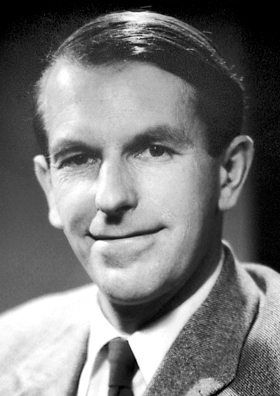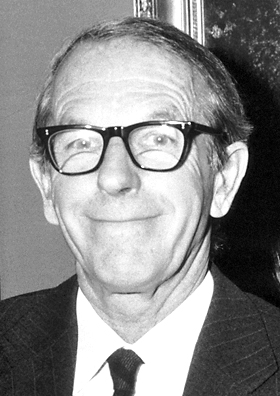<Back to Index>
- Biochemist Frederick Sanger, 1918
- Composer Salomon Jadassohn, 1831
- King of Castilla y León Alfonso XI el Justiciero, 1311
PAGE SPONSOR



Frederick Sanger, OM, CH, CBE, FRS (13 August 1918 - 19 November 2013) was an English biochemist and a two-time Nobel laureate in chemistry,
the only person to have been so. In 1958 he was awarded a Nobel prize
in chemistry "for his work on the structure of proteins, especially that
of insulin". In 1980, Walter Gilbert and
Sanger shared half of the chemistry prize "for their contributions
concerning the determination of base sequences in nucleic acids". The
other half was awarded to Paul Berg "for his fundamental studies of the biochemistry of nucleic acids, with particular regard to recombinant - DNA". He is the fourth person to have been awarded two Nobel Prizes, either individually or in tandem with others.
Frederick Sanger was born on 13 August 1918 in Rendcomb, a small village in Gloucestershire, the second son of Frederick Sanger, a general practitioner, and his wife, Cicely Sanger née Crewdson. He was one of three children. His brother, Theodore was only a year older while his sister May (Mary) was five years younger. His father, Frederick Sanger senior, had worked as an Anglican medical missionary in China but returned to England because of ill health. He was 40 in 1916 when he married Cicely who was 4 years younger. Sanger’s father converted to Quakerism soon after his two sons were born and brought up the children as Quakers. Sanger’s mother was the daughter of a wealthy cotton manufacturer and had a Quaker background but Cicely herself was not a Quaker.
When Sanger was around five years old the family moved to the small village of Tanworth - in - Arden in Warwickshire. The family were reasonably wealthy and employed a governess to teach the children. In 1927, at the age of nine, he was sent to the Downs School a residential preparatory school run by Quakers near Malvern. His brother Theo was a year ahead of him at the same school. In 1932, at the age of 14, he was sent to the recently established Bryanston School in Dorset. This used the Dalton system and had a more liberal regime which Sanger much preferred. At the school he liked his teachers and particularly enjoyed scientific subjects.
He achieved good results in the School Certificate examinations and in 1936 moved as an undergraduate to St John's College, Cambridge, to study natural sciences. His father had attended the same college. For Part I of his Tripos he took courses in physics, chemistry, biochemistry and mathematics but struggled with physics and mathematics. Many of the other students had studied more mathematics at school. In his second year he replaced physics with physiology. He took three years to obtain his Part I. For his Part II he studied biochemistry. It was a relatively new department founded by Gowland Hopkins with enthusiastic lecturers who included Malcolm Dixon, Joseph Needham and Ernest Baldwin. Sanger graduated with a first class degree in 1939.
Both his parents died from cancer during his first two years at Cambridge. His father was 60 and mother 58. As an undergraduate Sanger’s beliefs were strongly influenced by his Quaker upbringing. He was a pacifist and a member of the Peace Pledge Union. It was through his involvement with the Cambridge Scientists’ Anti - War Group that he met his future wife, Joan Howe, who was studying economics at Newnham College. They courted while he was studying for his Part II exams and married after he had graduated in December 1940. With the onset of the Second World War in 1939, he was granted unconditional exemption from military service as a conscientious objector.
Sanger began studying for a PhD in October 1940 under N.W. "Bill" Pirie.
His project was to investigate whether edible protein could be obtained
from grass. After little more than a month Pirie left the department
and Albert Neuberger became
his adviser. Sanger changed his research project to study the
metabolism of lysine and a more practical problem concerning the
nitrogen of potatoes. His thesis had the title: "The metabolism of the amino acid lysine in the animal body". He was examined by Charles Harington and Albert Charles Chibnall and awarded his doctorate in 1943.
Neuberger moved to the National Institute for Medical Research in London but Sanger stayed in Cambridge and in 1943 joined the group of Charles Chibnall, a protein chemist who had recently taken up the chair in the Department of Biochemistry. Chibnall had already done some work on the amino acid composition of bovine insulin and suggested that Sanger look at the amino groups in the protein. Insulin could be purchased from Boots and was one of the very few proteins that were available in a pure form. Up to this time Sanger had been funding himself. In Chibnall's group he was initially supported by the Medical Research Council and then from 1944 until 1951 by a Beit Memorial Fellowship for Medical Research.
Sanger's first triumph was to determine the complete amino acid sequence of the two polypeptide chains of bovine insulin in 1951. Prior to this it was widely assumed that proteins were somewhat amorphous. In determining these sequences, Sanger proved that proteins have a defined chemical composition. For this purpose he used the "Sanger Reagent", fluorodinitrobenzene (FDNB), to react with the exposed amino groups in the protein and in particular with the N-terminal amino group at one end of the polypeptide chain. He then partially hydrolysed the insulin into short peptides (either with hydrochloric acid or using an enzyme such as trypsin). The mixture of peptides was fractionated in two dimensions on a sheet of filter paper: first by electrophoresis in one dimension and then, perpendicular to that, by chromatography in the other. The different peptide fragments of insulin, detected with ninhydrin, moved to different positions on the paper, creating a distinct pattern which Sanger called "fingerprints". The peptide from the N-terminus could be recognised by the yellow colour imparted by the FDNB label and the identity of the labelled amino acid at the end of the peptide determined by complete acid hydrolysis and discovering which dinitrophenyl - amino acid was there. By repeating this type of procedure Sanger was able to determine the sequences of the many peptides generated using different methods for the initial partial hydrolysis. These could then be assembled into the longer sequences to deduce the complete structure of insulin. Sanger's principal conclusion was that the two polypeptide chains of the protein insulin had precise amino acid sequences and, by extension, that every protein had a unique sequence. It was this achievement that earned him his first Nobel prize in Chemistry in 1958. This discovery was crucial for the later sequence hypothesis of Crick for developing ideas of how DNA codes for proteins.
From 1951 Sanger was a member of the external staff of the Medical Research Council and when they opened the Laboratory of Molecular Biology in
1962, he moved from his laboratories in the Biochemistry Department of
the university to the top floor of the new building. He became head of
the Protein Chemistry division. Soon after his move he started looking
at the possibility of sequencing RNA molecules and began developing
methods for separating ribonucleotide fragments generated with specific
nucleases. One of the problems was to obtain a pure piece of RNA to
sequence. In the course of this he discovered in 1964, with Kjeld
Marcker, the formylmethionine tRNA which initiates protein synthesis in bacteria. He was beaten in the race to be the first to sequence a tRNA molecule by a group led by Robert Holley from Cornell University who published the sequence of the 77 ribonucleotides of alanine tRNA from Saccharomyces cerevisiae in 1965. By 1967 Sanger's group had determined the nucleotide sequence of the 5S ribosomal RNA from Escherichia coli, a small RNA of 120 nucleotides.
He then turned to sequencing DNA which would require an entirely different approach. He looked at different ways of using DNA polymerase I from E. coli to copy single stranded DNA. In 1975 together with Alan Coulson he published a sequencing procedure using DNA polymerase with radiolabelled nucleotides that he called the "Plus and Minus" technique. This involved two closely related methods that generated short oligonucleotides with defined 3' termini. These could be fractionated by electrophoresis on a polyacrylamide gel and visualised using autoradiography. The procedure could sequence up to 80 nucleotides in one go and was a big improvement on what gone before but was still very laborious. Nevertheless his group were able to sequence most of the 5,386 nucleotides of the single - stranded bacteriophage φX174. This was the first fully sequenced DNA - based genome. To their surprise they discovered that the coding regions of some of the genes overlapped with one another.
In 1977 Sanger and colleagues introduced the "dideoxy" chain - termination method for sequencing DNA molecules, also known as the "Sanger method". This was a major breakthrough and allowed long stretches of DNA to be rapidly and accurately sequenced. It earned him his second Nobel prize in Chemistry in 1980, which he shared with Walter Gilbert and Paul Berg. The new method was used by Sanger and colleagues to sequence human mitochondrial DNA (16,569 base pairs) and bacteriophage λ (48,502 base pairs). The dideoxy method was eventually used to sequence the entire human genome.
He is thus far (2011) the only person to have been awarded two Nobel Prizes in Chemistry, and one of only four two - time Nobel laureates: the other three were Marie Curie (Physics, 1903 and Chemistry, 1911), Linus Pauling (Chemistry, 1954 and Peace, 1962) and John Bardeen (twice Physics, 1956 and 1972).
Sanger
married Margaret Joan Howe in 1940. They have three children: Robin,
born in 1943, Peter born in 1946 and Sally Joan born in 1960.
Sanger retired in 1983 to his home, "Far Leys", in Swaffham Bulbeck outside Cambridge.
In 1992, the Wellcome Trust and the Medical Research Council founded the Sanger Centre (now the Sanger Institute), named after him. The Institute is located on the Wellcome Trust Genome Campus near Hinxton, only a few miles from Sanger's home. He agreed to having the Centre named after him when asked by John Sulston, the founding director, but warned, "It had better be good." It was opened by Sanger himself on 4 October 1993, with a staff of less than 50 people, and went on to take a leading role in the sequencing of the human genome. The Institute now has over 900 people and is one of the world's largest genomic research centres.
Although he retained his dislike of violence, he lost his religious faith and called himself an agnostic. In an interview published in the Times newspaper in 2000 Sanger is quoted as saying: "My father was a committed Quaker and I was brought up as a Quaker, and for them truth is very important. I drifted away from those beliefs - one is obviously looking for truth but one needs some evidence for it. Even if I wanted to believe in God I would find it very difficult. I would need to see proof."
He declined the offer of a knighthood as he did not wish to be addressed as "Sir" but later accepted the award of an Order of Merit.
In 2007 the British Biochemical Society was
given a grant by the Wellcome Trust to catalogue and preserve the 35
laboratory notebooks in which Sanger recorded his remarkable research
from 1944 to 1983. In reporting this matter, Science magazine noted that Sanger, "the most self - effacing person you could hope to meet", now was spending his time gardening at his Cambridgeshire home.
